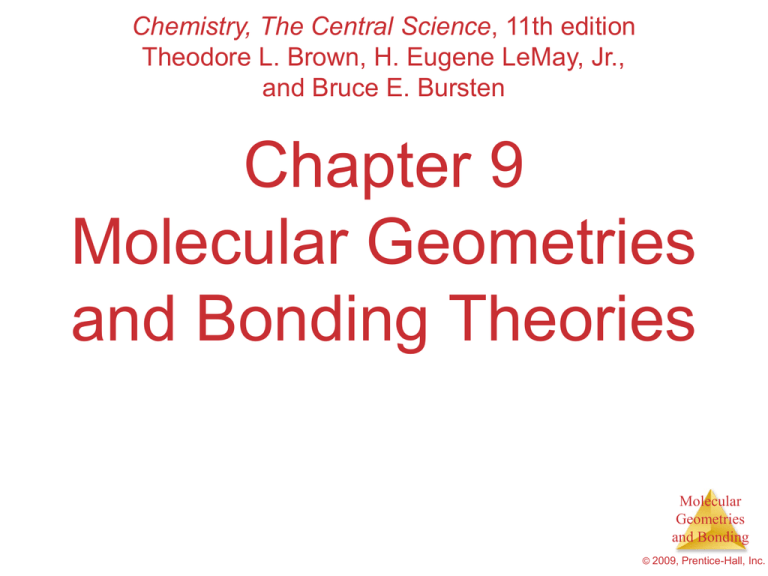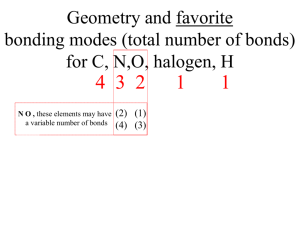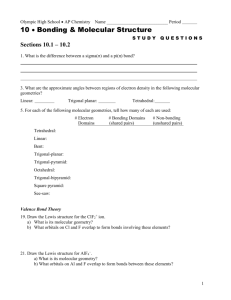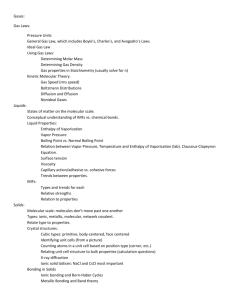Molecular Geometry - AP Chemistry with dr hart
advertisement

Chemistry, The Central Science, 11th edition Theodore L. Brown, H. Eugene LeMay, Jr., and Bruce E. Bursten Chapter 9 Molecular Geometries and Bonding Theories Molecular Geometries and Bonding © 2009, Prentice-Hall, Inc. Overview of Chapter 9 – Molecular Geometry Review/On your own: • • • • the basics of VSEPR theory – the reasoning (valence electrons repel one another) shapes based on VSEPR - linear (two electron domains), trigonal planar (three domains), tetrahedral (four domains), trigonal bipyramidal (five domains) and octahedral (six domains) use Lewis Structures to predict molecular geometry predict polarity of simple molecules, knowing their shapes, presence of lone pairs and differences in electronegativity New Material: • the use of electron domains, and especially nonbonding pairs of electrons (lone pairs) to determine a molecule’s shape, including shapes based on trigonal bipyramidal and octahedral • the effect of lone pairs on bond angles due to their greater repulsion than bonded pairs of electrons • application of VSEPR to larger molecules • express molecular polarity in terms of dipole moments • valence bond theory • hybrid orbitals • sigma and pi bonds in multiple bonds Molecular Geometries and resonance structures and Bonding © 2009, Prentice-Hall, Inc. Molecular Shapes • The shape of a molecule plays an important role in its reactivity. • By noting the number of bonding and nonbonding electron pairs we can easily predict the shape of Molecular the molecule. Geometries and Bonding © 2009, Prentice-Hall, Inc. What Determines the Shape of a Molecule? • Simply put, electron pairs, whether they be bonding or nonbonding, repel each other. • By assuming the electron pairs are placed as far as possible from each other, we can predict the shape of the molecule. Molecular Geometries and Bonding © 2009, Prentice-Hall, Inc. Electron Domains • The central atom in this molecule, A, has four electron domains. • We can refer to the electron pairs as electron domains. • In a double or triple bond, all electrons shared between those two atoms are on the same side of the central atom; therefore, they count as one electron domain. Molecular Geometries and Bonding © 2009, Prentice-Hall, Inc. Valence Shell Electron Pair Repulsion Theory (VSEPR) “The best arrangement of a given number of electron domains is the one that minimizes the repulsions among them.” Molecular Geometries and Bonding © 2009, Prentice-Hall, Inc. Electron-Domain Geometries These are the electron-domain geometries for two through six electron domains around a central atom. Molecular Geometries and Bonding © 2009, Prentice-Hall, Inc. Electron-Domain Geometries • All one must do is count the number of electron domains in the Lewis structure. • The geometry will be that which corresponds to the number of electron domains. Molecular Geometries and Bonding © 2009, Prentice-Hall, Inc. Molecular Geometries • The electron-domain geometry is often not the shape of the molecule, however. • The molecular geometry is that defined by the positions of only the atoms in the molecules, Molecular not the nonbonding pairs. Geometries and Bonding © 2009, Prentice-Hall, Inc. Sample Exercise 9.1 (p. 350) Use the VSEPR model to predict the molecular geometries of a) O3 b) SnCl3- Molecular Geometries and Bonding © 2009, Prentice-Hall, Inc. Sample Exercise 9.1 (p. 350) Use the VSEPR model to predict the molecular geometries of a) O3 bent (single lone pair) b) SnCl3trigonal pyramidal Molecular Geometries and Bonding © 2009, Prentice-Hall, Inc. Practice Exercise 1 (9.1) Consider the AB3 molecules and ions: PCl3, SO3, AlCl3, SO32-, and CH3+. How many of these molecules and ions do you predict to have a trigonal-planar geometry? a)1 b)2 c)3 d)4 e)5 Molecular Geometries and Bonding © 2009, Prentice-Hall, Inc. Practice Exercise 1 (9.1) Consider the AB3 molecules and ions: PCl3, SO3, AlCl3, SO32-, and CH3+. How many of these molecules and ions do you predict to have a trigonal-planar geometry? a)1 b)2 c)3 d)4 e)5 Molecular Geometries and Bonding © 2009, Prentice-Hall, Inc. Practice Exercise 2 (9.1) Predict the electron-domain geometry and the molecular geometry for a) SeCl2 bent (2 lone pairs) b) CO32trigonal planar Molecular Geometries and Bonding © 2009, Prentice-Hall, Inc. Molecular Geometries Within each electron domain, then, there might be more than one molecular geometry. Molecular Geometries and Bonding © 2009, Prentice-Hall, Inc. Linear Electron Domain • In the linear domain, there is only one molecular geometry: linear. • NOTE: If there are only two atoms in the molecule, the molecule will be linear no matter what the electron domain is. Molecular Geometries and Bonding © 2009, Prentice-Hall, Inc. Trigonal Planar Electron Domain • There are two molecular geometries: – Trigonal planar, if all the electron domains are bonding, – Bent, if one of the domains is a nonbonding pair. Molecular Geometries and Bonding © 2009, Prentice-Hall, Inc. Nonbonding Pairs and Bond Angle • Nonbonding pairs are physically larger than bonding pairs. • Therefore, their repulsions are greater; this tends to decrease bond angles in a molecule. Molecular Geometries and Bonding © 2009, Prentice-Hall, Inc. Multiple Bonds and Bond Angles • Double and triple bonds place greater electron density on one side of the central atom than do single bonds. • Therefore, they also affect bond angles. Molecular Geometries and Bonding © 2009, Prentice-Hall, Inc. Tetrahedral Electron Domain • There are three molecular geometries: – Tetrahedral, if all are bonding pairs, – Trigonal pyramidal if one is a nonbonding pair, – Bent if there are two nonbonding pairs. Molecular Geometries and Bonding © 2009, Prentice-Hall, Inc. Trigonal Bipyramidal Electron Domain • There are two distinct positions in this geometry: – Axial – Equatorial Molecular Geometries and Bonding © 2009, Prentice-Hall, Inc. Trigonal Bipyramidal Electron Domain Lower-energy conformations result from having nonbonding electron pairs in equatorial, rather than axial, positions in this geometry. Molecular Geometries and Bonding © 2009, Prentice-Hall, Inc. Trigonal Bipyramidal Electron Domain • There are four distinct molecular geometries in this domain: – – – – Trigonal bipyramidal Seesaw T-shaped Linear Molecular Geometries and Bonding © 2009, Prentice-Hall, Inc. Octahedral Electron Domain • All positions are equivalent in the octahedral domain. • There are three molecular geometries: – Octahedral – Square pyramidal – Square planar Molecular Geometries and Bonding © 2009, Prentice-Hall, Inc. Sample Exercise 9.2 (p. 354) Use the VSEPR model to predict the molecular geometry of a) SF4 b) IF5 Molecular Geometries and Bonding © 2009, Prentice-Hall, Inc. Practice Exercise 1 (9.2) A certain AB4 molecule has a square-planar molecular geometry. Which of the following statements about the molecule is or are true? i.The molecule has four electron domains about the central atom ii.The B-A-B angles between neighboring B atoms is 90o. iii. The molecule has two nonbonding pairs of electrons on atom A. a) Only one of the statements is true. b) Statements (i) and (ii) are true. c) Statements (i) and (iii) are true. d) Statements (ii) and (iii) are true. e) All three statements are true. Molecular Geometries and Bonding © 2009, Prentice-Hall, Inc. Practice Exercise 1 (9.2) A certain AB4 molecule has a square-planar molecular geometry. Which of the following statements about the molecule is or are true? i.The molecule has four electron domains about the central atom ii.The B-A-B angles between neighboring B atoms is 90o. iii. The molecule has two nonbonding pairs of electrons on atom A. a) Only one of the statements is true. b) Statements (i) and (ii) are true. c) Statements (i) and (iii) are true. d) Statements (ii) and (iii) are true. e) All three statements are true. Molecular Geometries and Bonding © 2009, Prentice-Hall, Inc. Practice Exercise 2 (9.2) Predict the electron-domain geometry and molecular geometry of a) BrF5+ b) SF5+ Molecular Geometries and Bonding © 2009, Prentice-Hall, Inc. Larger Molecules In larger molecules, it makes more sense to talk about the geometry about a particular atom rather than the geometry of the molecule as a whole. Molecular Geometries and Bonding © 2009, Prentice-Hall, Inc. Larger Molecules This approach makes sense, especially because larger molecules tend to react at a particular site in the molecule. Molecular Geometries and Bonding © 2009, Prentice-Hall, Inc. Sample Exercise 9.3 (p. 355) Eyedrops for dry eyes usually contain a water-soluble polymer called polyvinylalcohol, which is based on the unstable organic molecule called vinyl alcohol. Predict the approximate values for the H-O-C and O-C-C bond angles in vinyl alcohol. Molecular Geometries and Bonding © 2009, Prentice-Hall, Inc. Practice Exercise 1 (9.3) The atoms of the compound methylhydrazine, CH6N2, which is used as a rocket propellant, are connected as follows (note that lone pairs are not shown): See p. 356 in your textbook. a)What do you predict for the ideal values of the C-N-N and H-N-H angles, respectively? b)109.5o and 109.5o c)109.5o and 120o d)120o and 109.5o e)120o and 120o Molecular Geometries f)None of the above and Bonding © 2009, Prentice-Hall, Inc. Practice Exercise 1 (9.3) The atoms of the compound methylhydrazine, CH6N2, which is used as a rocket propellant, are connected as follows (note that lone pairs are not shown): See p. 356 in your textbook. a)What do you predict for the ideal values of the C-N-N and H-N-H angles, respectively? b)109.5o and 109.5o c)109.5o and 120o d)120o and 109.5o e)120o and 120o Molecular Geometries f)None of the above and Bonding © 2009, Prentice-Hall, Inc. Practice Exercise 2 (9.3) Predict the H—C—H and C—C—C bond angles in the molecule shown, called propyne. Molecular Geometries and Bonding © 2009, Prentice-Hall, Inc. Polarity • In Chapter 8 we discussed bond dipoles. • But just because a molecule possesses polar bonds does not mean the molecule as a whole will be polar. Molecular Geometries and Bonding © 2009, Prentice-Hall, Inc. Polarity By adding the individual bond dipoles, one can determine the overall dipole moment for the molecule. Molecular Geometries and Bonding © 2009, Prentice-Hall, Inc. Polarity Molecular Geometries and Bonding © 2009, Prentice-Hall, Inc. Sample Exercise 9.4 (p. 357) Predict whether the following molecules are polar or nonpolar: a) BrCl b) SO2 c) SF6 Molecular Geometries and Bonding © 2009, Prentice-Hall, Inc. Practice Exercise 1 (9.4) Consider an AB3 molecule in which A and B differ in electronegativity. You are told that the molecule has an overall dipole moment of zero. Which of the following could be the molecular geometry of the molecule? a)Trigonal pyramidal b)Trigonal planar c)T-shaped d)Tetrahedral e)More than one of the above Molecular Geometries and Bonding © 2009, Prentice-Hall, Inc. Practice Exercise 1 (9.4) Consider an AB3 molecule in which A and B differ in electronegativity. You are told that the molecule has an overall dipole moment of zero. Which of the following could be the molecular geometry of the molecule? a)Trigonal pyramidal b)Trigonal planar c)T-shaped d)Tetrahedral e)More than one of the above Molecular Geometries and Bonding © 2009, Prentice-Hall, Inc. Practice Exercise 2 (9.4) Determine whether the following molecules are polar or nonpolar: a) SF4 b) SiCl4 Molecular Geometries and Bonding © 2009, Prentice-Hall, Inc. Overlap and Bonding • We think of covalent bonds forming through the sharing of electrons by adjacent atoms. • In such an approach this can only occur when orbitals on the two atoms overlap. Molecular Geometries and Bonding © 2009, Prentice-Hall, Inc. Overlap and Bonding • Increased overlap brings the electrons and nuclei closer together while simultaneously decreasing electronelectron repulsion. • However, if atoms get too close, the internuclear repulsion greatly raises the energy. Molecular Geometries and Bonding © 2009, Prentice-Hall, Inc. Hybrid Orbitals But it’s hard to imagine tetrahedral, trigonal bipyramidal, and other geometries arising from the atomic orbitals we recognize. Molecular Geometries and Bonding © 2009, Prentice-Hall, Inc. Hybrid Orbitals • Consider beryllium: – In its ground electronic state, it would not be able to form bonds because it has no singly-occupied orbitals. Molecular Geometries and Bonding © 2009, Prentice-Hall, Inc. Hybrid Orbitals But if it absorbs the small amount of energy needed to promote an electron from the 2s to the 2p orbital, it can form two bonds. Molecular Geometries and Bonding © 2009, Prentice-Hall, Inc. Hybrid Orbitals • Mixing the s and p orbitals yields two degenerate orbitals that are hybrids of the two orbitals. – These sp hybrid orbitals have two lobes like a p orbital. – One of the lobes is larger and more rounded as is the s orbital. Molecular Geometries and Bonding © 2009, Prentice-Hall, Inc. Hybrid Orbitals • These two degenerate orbitals would align themselves 180 from each other. • This is consistent with the observed geometry of beryllium compounds: linear. Molecular Geometries and Bonding © 2009, Prentice-Hall, Inc. Hybrid Orbitals • With hybrid orbitals the orbital diagram for beryllium would look like this. • The sp orbitals are higher in energy than the 1s orbital but lower than the 2p. Molecular Geometries and Bonding © 2009, Prentice-Hall, Inc. Hybrid Orbitals Using a similar model for boron leads to… Molecular Geometries and Bonding © 2009, Prentice-Hall, Inc. Hybrid Orbitals …three degenerate sp2 orbitals. Molecular Geometries and Bonding © 2009, Prentice-Hall, Inc. Hybrid Orbitals With carbon we get… Molecular Geometries and Bonding © 2009, Prentice-Hall, Inc. Hybrid Orbitals …four degenerate sp3 orbitals. Molecular Geometries and Bonding © 2009, Prentice-Hall, Inc. Hybrid Orbitals Current evidence suggests hybridization involving d orbitals does not exist. Molecular Geometries and Bonding © 2009, Prentice-Hall, Inc. Sample Exercise 9.5 (p. 365) Indicate the hybridization of orbitals employed by the central atom in each of the following: a) NH2- Molecular Geometries and Bonding © 2009, Prentice-Hall, Inc. Practice Exercise 1 (9.5) For which of the following molecules or ions does the following description apply? “The bonding can be explained using a set of sp2 hybrid orbitals on the central atom, with one of the hybrid orbitals holding a nonbonding pair of electrons.” a)CO2 b)H2S c)O3 d)CO32e)more than one of the above Molecular Geometries and Bonding © 2009, Prentice-Hall, Inc. Practice Exercise 1 (9.5) For which of the following molecules or ions does the following description apply? “The bonding can be explained using a set of sp2 hybrid orbitals on the central atom, with one of the hybrid orbitals holding a nonbonding pair of electrons.” a) CO2 b) H2S c) O3 d) CO32e) more than one of the above Molecular Geometries and Bonding © 2009, Prentice-Hall, Inc. Practice Exercise 2 (9.5) Predict the electron-domain geometry and the hybridization of the central atom in a) SO32- Molecular Geometries and Bonding © 2009, Prentice-Hall, Inc. Hybrid Orbitals Once you know the electron-domain geometry, you know the hybridization state of the atom. Note: ignore hybridizations involving d orbitals – probably do not exist Molecular Geometries and Bonding © 2009, Prentice-Hall, Inc. Valence Bond Theory • Hybridization is a major player in this approach to bonding. • There are two ways orbitals can overlap to form bonds between atoms. Molecular Geometries and Bonding © 2009, Prentice-Hall, Inc. Sigma () Bonds • Sigma bonds are characterized by – Head-to-head overlap. – Cylindrical symmetry of electron density about the internuclear axis. Molecular Geometries and Bonding © 2009, Prentice-Hall, Inc. Pi () Bonds • Pi bonds are characterized by – Side-to-side overlap. – Electron density above and below the internuclear axis. Molecular Geometries and Bonding © 2009, Prentice-Hall, Inc. Single Bonds Single bonds are always bonds, because overlap is greater, resulting in a stronger bond and more energy lowering. Molecular Geometries and Bonding © 2009, Prentice-Hall, Inc. Multiple Bonds In a multiple bond one of the bonds is a bond and the rest are bonds. Molecular Geometries and Bonding © 2009, Prentice-Hall, Inc. Multiple Bonds • In a molecule like formaldehyde (shown at left) an sp2 orbital on carbon overlaps in fashion with the corresponding orbital on the oxygen. • The unhybridized p orbitals overlap in fashion. Molecular Geometries and Bonding © 2009, Prentice-Hall, Inc. Multiple Bonds In triple bonds, as in acetylene, two sp orbitals form a bond between the carbons, and two pairs of p orbitals overlap in fashion to form the two bonds. Molecular Geometries and Bonding © 2009, Prentice-Hall, Inc. Sample Exercise 9.6 (p. 368) Describe how the bonds in formaldehyde are formed in terms of overlaps of appropriate hybridized and unhybridized orbitals. Molecular Geometries and Bonding © 2009, Prentice-Hall, Inc. Practice Exercise 1 (9.6) We have just arrived at a bonding description for the formaldehyde molecule. Which of the following statements about the molecule is or are true? i.Two of the electrons in the molecule are used to make the p bond in the molecule. ii.Six of the electrons in the molecule are used to make the s bonds in the molecule. iii.The C-O bond length in formaldehyde should be shorter than that in methanol, H3COH. a)Only one of the statements is true. b)Statements (i) and (ii) are true. c)Statements (i) and (iii) are true. d)Statements (ii) and (iii) are true. e)All three statements are true. Molecular Geometries and Bonding © 2009, Prentice-Hall, Inc. Practice Exercise 1 (9.6) We have just arrived at a bonding description for the formaldehyde molecule. Which of the following statements about the molecule is or are true? i.Two of the electrons in the molecule are used to make the p bond in the molecule. ii.Six of the electrons in the molecule are used to make the s bonds in the molecule. iii.The C-O bond length in formaldehyde should be shorter than that in methanol, H3COH. a)Only one of the statements is true. b)Statements (i) and (ii) are true. c)Statements (i) and (iii) are true. d)Statements (ii) and (iii) are true. e)All three statements are true. Molecular Geometries and Bonding © 2009, Prentice-Hall, Inc. Practice Exercise 2 (9.6) Consider the acetonitrile molecule: a) Predict the bond angles around each carbon atom b) Describe the hybridization at each of the carbon atoms c) Determine the total number s and p bonds in the molecule. Molecular Geometries and Bonding © 2009, Prentice-Hall, Inc. Delocalized Electrons: Resonance When writing Lewis structures for species like the nitrate ion, we draw resonance structures to more accurately reflect the structure of the molecule or ion. Molecular Geometries and Bonding © 2009, Prentice-Hall, Inc. Delocalized Electrons: Resonance • In reality, each of the four atoms in the nitrate ion has a p orbital. • The p orbitals on all three oxygens overlap with the p orbital on the central nitrogen. Molecular Geometries and Bonding © 2009, Prentice-Hall, Inc. Delocalized Electrons: Resonance This means the electrons are not localized between the nitrogen and one of the oxygens, but rather are delocalized throughout the ion. Molecular Geometries and Bonding © 2009, Prentice-Hall, Inc. Resonance The organic molecule benzene has six bonds and a p orbital on each carbon atom. Molecular Geometries and Bonding © 2009, Prentice-Hall, Inc. Resonance • In reality the electrons in benzene are not localized, but delocalized. • The even distribution of the electrons in benzene makes the molecule unusually stable. Molecular Geometries and Bonding © 2009, Prentice-Hall, Inc. Sample Exercise 9.7 (p. 371) Describe the bonding in the nitrate ion, NO3-. Does this ion have delocalized bonds? Molecular Geometries and Bonding © 2009, Prentice-Hall, Inc. Practice Exercise 1 (9.7) How many electrons are in the p system of the ozone molecule, O3? a)2 b)4 c)6 d)14 e)18 Molecular Geometries and Bonding © 2009, Prentice-Hall, Inc. Practice Exercise 1 (9.7) How many electrons are in the system of the ozone molecule, O3? a)2 b)4 c)6 d)14 e)18 Molecular Geometries and Bonding © 2009, Prentice-Hall, Inc. Practice Exercise 2 (9.7) Which of the following molecules or ions will exhibit delocalized bonding? SO2, SO3, SO32-, H2CO, NH4+. Molecular Geometries and Bonding © 2009, Prentice-Hall, Inc. Sample Integrative Exercise (p. 386) Elemental sulfur is a yellow solid that consists of S8 molecules. The structure of the S8 molecule is a puckered, eight-membered ring. Molecular Geometries and Bonding © 2009, Prentice-Hall, Inc. Sample Integrative Exercise (p. 386) Heating elemental sulfur to high temperatures produces gaseous S2 molecules.: S8(s) 4 S2(g) a) With respect to electronic structure, which element in the second row of the periodic table is most similar to sulfur? b) Use the VSEPR model to predict the S-S-S bond angles in S8 and the hybridization at S in S8. d) Use bond enthalpies (Table 8.4) to estimate the enthalpy change for the reaction just described. Is the reaction exothermic or endothermic? Molecular Geometries and Bonding © 2009, Prentice-Hall, Inc.





